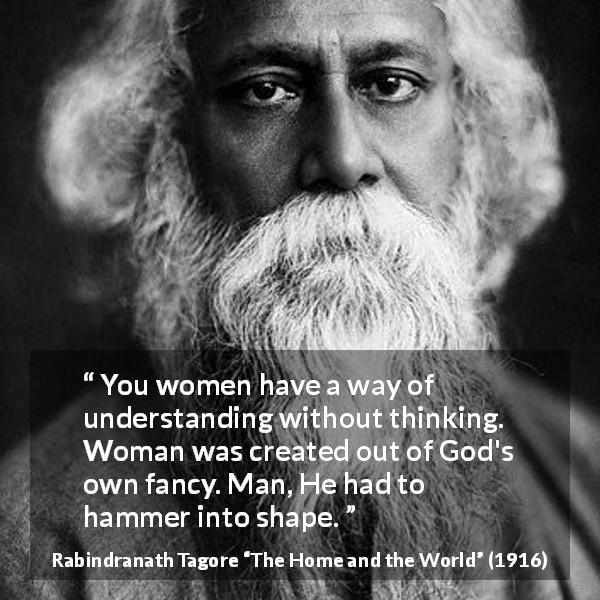

Nikhil, who was keen on social reform but repulsed by nationalism, gradually loses the esteem of his spirited wife, Bimala, because of his failure to be enthusiastic about anti-British agitations, which she sees as a lack of patriotic commitment. Through the love-triangle, Tagore explores the war between idealism and pragmatism inside Bimala’s mind and extends its sphere of influence to encompass the issues dividing India during those times of strife and struggle through the depiction of the revolution and the Swadeshi movement. She emotionally trips, vacillates between Sandip and her husband, and decides to take side with Sandip until she returnes home bruised and humiliated but with a more mature understanding of both Nikhil, her Home, and Sandip, the World.

Nikhil is the man of her home Sandip represents to her the outside world, not only because he is her link to the nation, her source of information to all that is happening outside her home in the country, but also because he is an outsider who embodies all the vitality and passion that she supposes the outside world to contain but that has been absent from her own domestic life. Smitten by Sandip's fiery speeches and his vision of her as the ‘Queen Bee’ as contrasted with her own husband Nikhil's ostensibly indifferent attitude towards the freedom struggle, Bimala finds herself increasingly attracted to Sandip. It was at the sight of Sandip that Bimala, drawn to his nationalistic fervour, makes the choice between staying inside her ‘home’ and meeting him in the outside ‘world’, and chooses the latter. Ironically, this crossing of the threshold coincides Sandip’s entrance into their lives proving, as Nikhil observed, ‘if you will not go to the world, the world will come to you’. It is due to Nikhil’s exertion that Bimala crosses the threshold of her secluded, sheltered ‘zenana’existence behind the purdah and enters the outside world. At some deeper into the novel, however, the title symbolizes the two ideologies Bimala must choose between - Nikhil’s pragmatism that represents the ‘home’ and Sandip’s idealism that represents the ‘world’. Moreover, Bimala is also torn between being a faithful wife of Nikhil who is her ‘home’, and Sandip her attraction and newly found love representing the outside ‘world’.

At one level it tells about the struggle of Bimala in choosing between her ‘home’ behind the purdah, the outside ‘world’ that her husband Nikhil has introduced her to. The title of the book The Home and the World by Rabindranath Tagore can be interpreted at various levels.


 0 kommentar(er)
0 kommentar(er)
